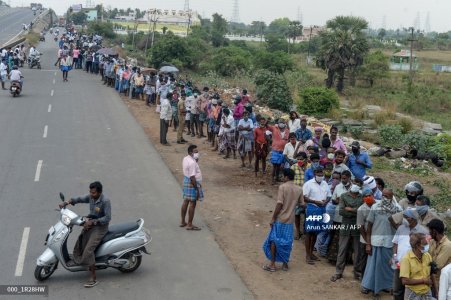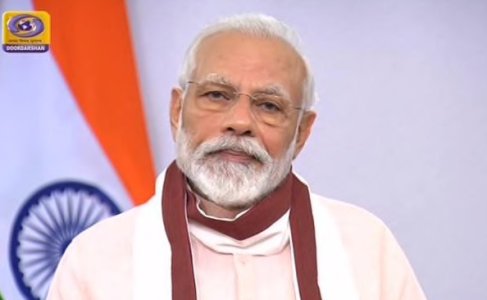- Joined
- Oct 2, 2004
- Runs
- 218,140
India will begin flights on Thursday to bring home some 400,000 citizens stranded overseas by travel restrictions due to the coronavirus pandemic, prompting concerns that imported infections could fuel contagion in the country.
India’s coronavirus cases totaled 49,390 as of Wednesday, with 1,694 deaths, and there is still no sign of the curve in new cases flattening despite a stringent, weeks-long lockdown in the world’s second most populous country.
But responding to the distress among India’s huge diaspora, the government has asked national carrier Air India to provide aircraft to bring back Indians who want to return from the Middle East, Singapore, the United Kingdom and the United States.
The Indian Navy has also been asked to help by sending two ships to evacuate citizens from the Maldives, in the Indian Ocean.
Migrant workers, students and business people were left with no way home after India suspended air travel in March, just before entering a nationwide shutdown that remains in force until 17 May.
There have been numerous tales of hardship, both financial and emotional, from people desperate to see sick relatives and attend funerals or births, while others have lost their jobs and are running out of money stranded abroad.
“Priority will be given to workers in distress, elderly people, urgent medical cases, pregnant women, as well as to other people who are stranded in difficult situations,” the Indian consulate general in Dubai said.
The first round of evacuations would bring back around 200,000 people by the middle of May and then by mid-June a total of 350,000-400,000 would be flown back, a foreign ministry official said.
“By then, we are hopeful that foreign travel will be re-opened,” the official said.
Four of the ten flights that Air India will operate on Thursday will bring back people from Dubai, Abu Dhabi, Riyadh and Doha and all into the southern state of Kerala, according to a seven-day flight plan released by the government.
Nearly 300,000 have signed up for the flights from the Middle East for which Air India is charging a little less than a normal commercial fare.
Passengers will be screened at the departing airport and only those who are asymptomatic will be allowed to board. Once they land, they will be quarantined for two weeks, the government said.
India’s coronavirus cases totaled 49,390 as of Wednesday, with 1,694 deaths, and there is still no sign of the curve in new cases flattening despite a stringent, weeks-long lockdown in the world’s second most populous country.
But responding to the distress among India’s huge diaspora, the government has asked national carrier Air India to provide aircraft to bring back Indians who want to return from the Middle East, Singapore, the United Kingdom and the United States.
The Indian Navy has also been asked to help by sending two ships to evacuate citizens from the Maldives, in the Indian Ocean.
Migrant workers, students and business people were left with no way home after India suspended air travel in March, just before entering a nationwide shutdown that remains in force until 17 May.
There have been numerous tales of hardship, both financial and emotional, from people desperate to see sick relatives and attend funerals or births, while others have lost their jobs and are running out of money stranded abroad.
“Priority will be given to workers in distress, elderly people, urgent medical cases, pregnant women, as well as to other people who are stranded in difficult situations,” the Indian consulate general in Dubai said.
The first round of evacuations would bring back around 200,000 people by the middle of May and then by mid-June a total of 350,000-400,000 would be flown back, a foreign ministry official said.
“By then, we are hopeful that foreign travel will be re-opened,” the official said.
Four of the ten flights that Air India will operate on Thursday will bring back people from Dubai, Abu Dhabi, Riyadh and Doha and all into the southern state of Kerala, according to a seven-day flight plan released by the government.
Nearly 300,000 have signed up for the flights from the Middle East for which Air India is charging a little less than a normal commercial fare.
Passengers will be screened at the departing airport and only those who are asymptomatic will be allowed to board. Once they land, they will be quarantined for two weeks, the government said.











 రాష్ట్రంలో గత 24 గంటల్లో (9AM-9AM)<br>* 9,628 సాంపిల్స్ ని పరీక్షించగా 48 మంది కోవిడ్19 పాజిటివ్ గా నిర్దారింపబడ్డారు. <br>* 101 మంది కోవిడ్ నుండి కోలుకొని సంపూర్ణ ఆరోగ్యం తో డిశ్చార్జ్ చేయబడ్డారు.<a href="https://twitter.com/hashtag/APFightsCorona?src=hash&ref_src=twsrc%5Etfw">#APFightsCorona</a> <a href="https://t.co/8HOO8GDLKd">pic.twitter.com/8HOO8GDLKd</a></p>— ArogyaAndhra (@ArogyaAndhra) <a href="https://twitter.com/ArogyaAndhra/status/1261538587847192576?ref_src=twsrc%5Etfw">May 16, 2020</a></blockquote> <script async src="https://platform.twitter.com/widgets.js" charset="utf-8"></script>
రాష్ట్రంలో గత 24 గంటల్లో (9AM-9AM)<br>* 9,628 సాంపిల్స్ ని పరీక్షించగా 48 మంది కోవిడ్19 పాజిటివ్ గా నిర్దారింపబడ్డారు. <br>* 101 మంది కోవిడ్ నుండి కోలుకొని సంపూర్ణ ఆరోగ్యం తో డిశ్చార్జ్ చేయబడ్డారు.<a href="https://twitter.com/hashtag/APFightsCorona?src=hash&ref_src=twsrc%5Etfw">#APFightsCorona</a> <a href="https://t.co/8HOO8GDLKd">pic.twitter.com/8HOO8GDLKd</a></p>— ArogyaAndhra (@ArogyaAndhra) <a href="https://twitter.com/ArogyaAndhra/status/1261538587847192576?ref_src=twsrc%5Etfw">May 16, 2020</a></blockquote> <script async src="https://platform.twitter.com/widgets.js" charset="utf-8"></script>